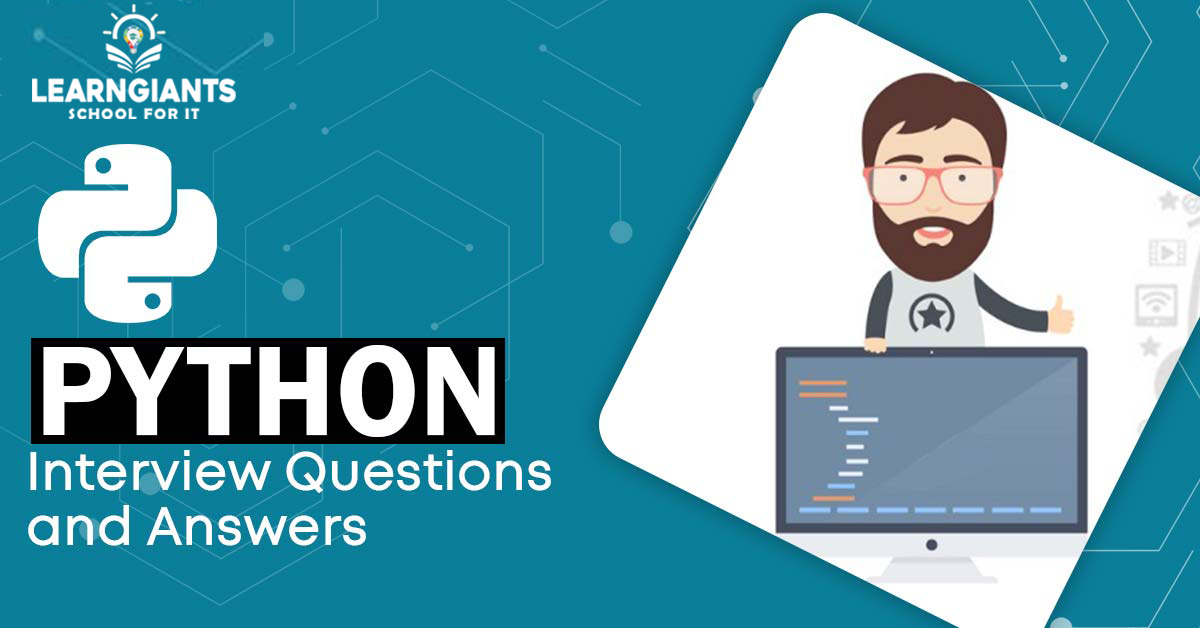Python Interview Questions and Answers

1. What is python?
Python is a language of general programming that is interpreted at a high level. It could be used to create virtually any kind of software with the correct tools / libraries since it has a basic function. Python also provides artifacts, modules, loops, extraordinary managing and automated memory management to modelle the problems of the modern world and construct applications.
2. What does interpreted language mean?
A language that is interpreted performs its statements line by line. Instances of interpreted languages are primarily languages such as javascript, html, R, Sql, or Ruby. Programs written in the language interpreted run from code base directly, without the possible influence in compiling them.
3. Explain memory management in Python
The Python File Manager performs resource maintenance in Python. The memory delegated by the operator is a personal Python heap area. The author can not control all Python artifacts in this heap and is privately held. However, python has some core API features to operate on the private heap field.
4. What are the uses of Lambda in Python?
In Python, Lambda is an unverified component that can recognize a lot of opinions, but has only one expression. It is usually used in situations where anonymous function is needed for a short amount of time. Any form, Lambda features may be used:Lambda functions are allocated to the attribute.In another feature, wrapping lambda function.
5. What are generators?
Generators are operators which return, one by one, a certain way, an iterable set of objects. Generators are generated generally by different approaches to create iterators. They use the keyword yield instead of returning a generator object.
6. Explain some features of Python
It embraces both organized and functional programming frameworks and OOPs.It could be used to create large applications as a scripting language or can be compiled into a byte code.It offers highly dynamic types of information and supports dynamic type control.Automatic waste collection is supported.C, C++, COM, CORBA and Ios can be quickly implemented.
7. What does PeP 8 mean?
PEP 8 is a protocol scripting, and a proposal to create a more accessible Python application.
8. Explain pickling & unpickling in Python
The Pickle subsystem acknowledges any php object, transforms into a string and dumps the object into a dump function, which is known as pickling. The process for recovery of original Python objects is called unpickling from the saved string representation.
9. What is namespace?
Each name implemented in Python has a place to stay and to be hooked. It is alluded to as a namespace. It's like a box in which the entity is labeled with a vector label. So when the function is checked, it is checked to get the value.
10. Explain the benefits of python
● Python provides a large library base on several Internet sites,
such as text, HTML, and so on.
● The interpreter itself transfers the memory to different
variables and frees them immediately. The intermediary does not
require complex memory management.
● Simple readability thanks to the usage of square brackets.
● For beginners, it's easy and quick to understand.
● The integrated data types save time and effort to declare
variables for programming
11. What is a Flask?
Flask is a Python web microframe and a micro-framework component. That means it will have little or no external library dependencies. This allows the system to be transparent when upgrading so less protection vulnerabilities are less based.
12. Explain Map function in Python
In Python the map function is efficient and iterable with two parameters. The map method takes an argument method and then applies it to all the elements of an iterable which are transferred as another claim. Returns a set of results items.
13. Explain Python module
The modules are separate Python files that can be reused using the import declaration or the.py extension in certain Python codes or files. A module can be made up of functions, groups and parameters or other applications. Modules are not only important to maintain Procedural codes structured but they also reduce the flexibility and reliability of codes.
14. What is NumPy?
The numerical python is NumPy. It can be used on numeric information stored in the monitor for effective and general numerical calculations. Order, index, reshape and more, for starters. Within this section, some linear algebraic functions are usable, but not total.
15. Explain SciPy in Python
SciPy is Scientific Python's term. This framework is a set of Python modules that are used for incorporation, separation and other operations. For algebraic calculations full-scale algebraic functions are usable in SciPy.
16. Explain whether python is an object oriented language?
Python implements an object-oriented system, with the exception of access specifiers, which includes the common OOP conceptualizations such as history, polymorphism and more. No powerful enumeration supports Python (adding private keywords to data members). It has, however, a protocol which can be used to cover the details, i.e. to prefix a two-underlaid details participant.
17. Explain control flow statements
To modify or alter the operation stream of a program, the control flow statements are used. In particular, the stream of compile time is from top to bottom, while some statements in Python may interrupt the sequence of operation start to finish. Declarations of power flow include decision-making, looping and other issues.
18. What do you mean by a docstring?
Docstrings are not the standard Python comments because Python document sequences are directly accessible at regular intervals using dot variables instead of being absolutely ignored by the Python Parser, as in the cases of discourse.
19. What are the advantages of NumPy arrays?
NumPy arrays use far less storage so that the code becomes much more effective.NumPy arrays operate quicker and therefore do not contribute to the system intensive loading.NumPy has a easily readable syntax that allows it for developers simple and functional
20. Explain loop interruption statements
There are 2 types as explained below- Python break statement: This declaration completes the loop automatically and the system management flow is moved to the outside of the chain explicitly. Python continue statement: Start declaration finishes the current loop iteration and transfers the system control stream to the next collectivities, such that even the current phase can be skipped.
21. Explain negative indexes
To reach an item from the organized series, the index of the object is used easily, which is its location number. The index usually begins from 0, i.e. the very first component is index 0, the second component is index 1, etc.
The index is called reverse indexing because you use the index for accessing items from the bottom of a document. The reverse indexing of the elements starts with the index number "−1" from the last element. The last second item has an index '−2,' etc. These indexes are referred to as negative indexes in reverse indexing.
22. What is a Python dictionary?
This is among the data for Python sponsored. This is a group of components which is not organized. Elements are classified as key-value pairs in dictionary definitions. Terms are labeled with buttons.
23. Explain Zip Function in Python
The function Python Zip returns a zip array that maps a several package index similarly. It accepts an iterable, transforms iterators and adds items dependent on passed iterables. It generates a multiple iterator.
24. Why is break statement used in python?
It is used to interrupt the present loop operation. Break everytime splits the implementation of the current block and transfers the controls. When the locks are in a loop, they leave this same loop, and when the break occurs in a loop, they leave the inner core loop.
25. Explain Tuple
A tuple is an optimized form of data set. This allows one to sequentially save prices. It is unchanging, so that the original data do not change. No element can be removed but can be found in the folder. Indexing can be used to obtain components. It also allows components to be crossed by negative indexation in the reverse order. Tuple follows specific approaches such as max(), (sorted), (Len), (sum).
26. What is an Operator?
An operator is a common sign used for each meaning and thus generates an output. A maker is operating on operands. Operands are integer liters or quantities representing other values. Unary, discrete or ternary operators may be the operators.

 WhatsApp Us
WhatsApp Us